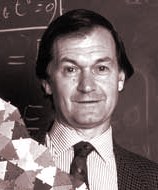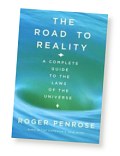The Road to Reality
The archetypal Roger Penrose book
 "If Albert Einstein were alive, he would have a copy of The Road to Reality
on his bookshelf. So would Isaac Newton. This may be the most complete
mathematical explanation of the universe yet published, and Roger Penrose
richly deserves the accolades he will receive for it."
"If Albert Einstein were alive, he would have a copy of The Road to Reality
on his bookshelf. So would Isaac Newton. This may be the most complete
mathematical explanation of the universe yet published, and Roger Penrose
richly deserves the accolades he will receive for it."
That said, explains amazon reviewer Therese Littleton, let us be perfectly clear: this is not an easy book to read. The number of people in the world who can understand everything in it could probably take a taxi together to Penrose's next lecture. Still, math-friendly readers looking for a substantial and possibly even thrillingly difficult intellectual experience should pick up a copy (carefully - it's over a thousand pages long and weighs nearly 4 pounds) and start at the beginning, where Penrose sets out his purpose: to describe "the search for the underlying principles that govern the behavior of our universe." Beginning with the deceptively simple geometry of Pythagoras and the Greeks, Penrose guides readers through the fundamentals--the incontrovertible bricks that hold up the fanciful mathematical structures of later chapters. From such theoretical delights as complex-number calculus, Riemann surfaces, and Clifford bundles, the tour takes us quickly on to the nature of spacetime. The bulk of the book is then devoted to quantum physics, cosmological theories (including Penrose's favored ideas about string theory and universal inflation), and what we know about how the universe is held together. For physicists, mathematicians, and advanced students, The Road to Reality is an essential field guide to the universe. For enthusiastic amateurs, the book is a project to tackle a bit at a time, one with unimaginable intellectual rewards.
 The publisher's own description also hints at the substance underpinning
Penrose's book: At first, this hefty new tome looks suspiciously like a
textbook, complete with hundreds of diagrams and pages full of mathematical
notation. On a closer reading, however, one discovers that the book is
something entirely different and far more remarkable. Unlike a textbook, the
purpose of which is purely to impart information, this volume is written to
explore the beautiful and elegant connection between mathematics and the
physical world. Penrose spends the first third of his book walking us
through a seminar in high-level mathematics, but only so he can present
modern physics on its own terms, without resorting to analogies or
simplifications (as he explains in his preface, "in modern physics, one
cannot avoid facing up to the subtleties of much sophisticated
mathematics").
The publisher's own description also hints at the substance underpinning
Penrose's book: At first, this hefty new tome looks suspiciously like a
textbook, complete with hundreds of diagrams and pages full of mathematical
notation. On a closer reading, however, one discovers that the book is
something entirely different and far more remarkable. Unlike a textbook, the
purpose of which is purely to impart information, this volume is written to
explore the beautiful and elegant connection between mathematics and the
physical world. Penrose spends the first third of his book walking us
through a seminar in high-level mathematics, but only so he can present
modern physics on its own terms, without resorting to analogies or
simplifications (as he explains in his preface, "in modern physics, one
cannot avoid facing up to the subtleties of much sophisticated
mathematics").
Those who work their way through these initial chapters will find themselves rewarded with a deep and sophisticated tour of the past and present of modern physics. Penrose transcends the constraints of the popular science genre with a unique combination of respect for the complexity of the material and respect for the abilities of his readers.
Penrose's book sometimes begs comparison with Hawking's A Brief History of Time, and while Penrose's vibrantly challenging volume deserves similar success, it will also likely lie unfinished on as many bookshelves as Hawking's. For those hardy readers willing to invest their time and mental energies, however, there are few books more deserving of the effort.
Buy your copy of Roger Penrose's Road to Reality from amazon.com now (If
you're in the UK click here
)